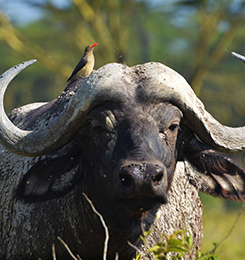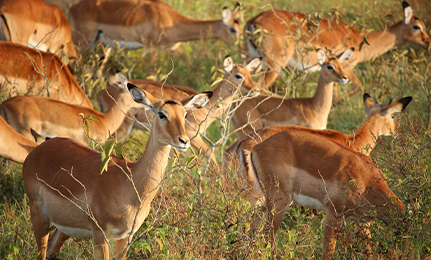
Augustino
Expeditions
Tanzania Western
Gombe Stream National Park, on the shores of Lake Tanganyika, is the smallest park in Tanzania. The park is located outside the Kigoma town about 16 kilometers covering only 52 square kilometers.
The park is narrow strip of a mountainous country bordered by the crest of the African Rift Valley walls to the east and Lake Tanganyika to the west the deepest cold water lake in Africa.
Gombe offers visitors the rare chance to observe the chimpanzee communities made famous by British explorer Jane Goodall. A number of monkey species can also be seen, red colobus, baboons, velvet, red-tail and blue monkey.
Other primates include bush pigs and bushbucks. The area is heavily forested, making it an unsuitable habitat for carnivores so the park is safe for walking safaris. There are rewarding sightings for birdwatchers.
The other sanctuary of the chimpanzee is the Mahale Mountains National Park which is reached by boat from Kigoma. Covering an area of 1,613 square kilometers, its western boundary is the shore of Lake Tanganyika. The vegetation of the Mahale is populated with the Miombo woodland, the narrow forest along the rivers.
The chimpanzee population of the park is estimated to about 1,000 which can be seen, in groups of between five and 30 at a time, in their natural habitat.
Other primates such as baboons and colobus monkeys, bush pig, porcupine and other animals are found in the north; while to the south live various antelope species, lion, elephant, buffalo and giraffe.
Main features of Tanzania's third largest park, located about 40 kilometers southwest of the town of Mpanda, are Lake Katavi, with its vast floodplains, the palm fringed Lake Chala and the Katuma River.
The park covers an area of approximately 4,500 square kilometers of unspoiled wilderness areas compare with other parks in the country.
The park is noted for Miombo woodland and scattered acacia trees scenery and is the home of zebras, sable and roan antelope, eland, leopard, elephant, buffalo and lion.
Waterfowl are also abundant. Lake Chala and River Katuma is particularly rich in bird life more than 400 species are recorded and are also known for its large concentration of crocodile and hippo.
Rubondo Island is tucked in the southwest corner of Lake Victoria covering an area of 457 sq km (176 sq miles), the world's second-largest lake, an inland sea sprawling between Tanzania, Uganda and Kenya. With nine smaller islands under its wing, Rubondo protects precious fish breeding grounds.
Rubondo is more than a water wonderland. Deserted sandy beaches nestle against a cloak of virgin forest, where dappled bushbuck move fleet yet silent through a maze of tamarinds, wild palms, and sycamore figs strung with a cage of trailing taproots.
A pair of fish eagles guards the gentle bay, their distinctive black, white and chestnut feather pattern gleaming boldly in the morning sun. Suddenly, the birds toss back their heads in a piercing, evocative duet. On the sandbank below, a well-fed monster of a crocodile snaps to life, startled from its nap. It stampedes through the crunchy undergrowth, crashing into the water in front of the boat, invisible except for a pair of sentry-post eyes that peek menacingly above the surface to monitor our movements.
Tasty tilapia form the staple diet of the yellow-spotted otters that frolic in the island's rocky coves, while rapacious Nile perch, some weighing more than 100kg, tempt recreational game fishermen seeking world record catches.
The shaggy-coated aquatic sitatunga, elsewhere the most elusive of antelopes, is remarkably easily observed, not only in the papyrus swamps it normally inhabits, but also in the forest interior.
Birds are everywhere.
Flocks of African grey parrots – released onto the island after they were confiscated from illegal exporters – screech in comic discord as they flap furiously between the trees.
The azure brilliance of a malachite kingfisher perched low on the reeds competes with the glamorous, flowing tail of a paradise flycatcher as it flits through the lakeshore forest. Herons, storks and spoonbills proliferate in the swampy lake fringes, supplemented by thousands of Eurasian migrants during the northern winter.
Wild jasmine, 40 different orchids and a smorgasbord of sweet, indefinable smells emanate from the forest.
Ninety percent of the park is humid forest; the remainder ranges from open grassland to lakeside papyrus beds.
A number of indigenous mammal species - hippo, vervet monkey, genet and mongoose - share their protected habitat with introduced species such as chimpanzee, black-and-white colobus, elephant and giraffe, all of which benefit from Rubondo's inaccessibility.






